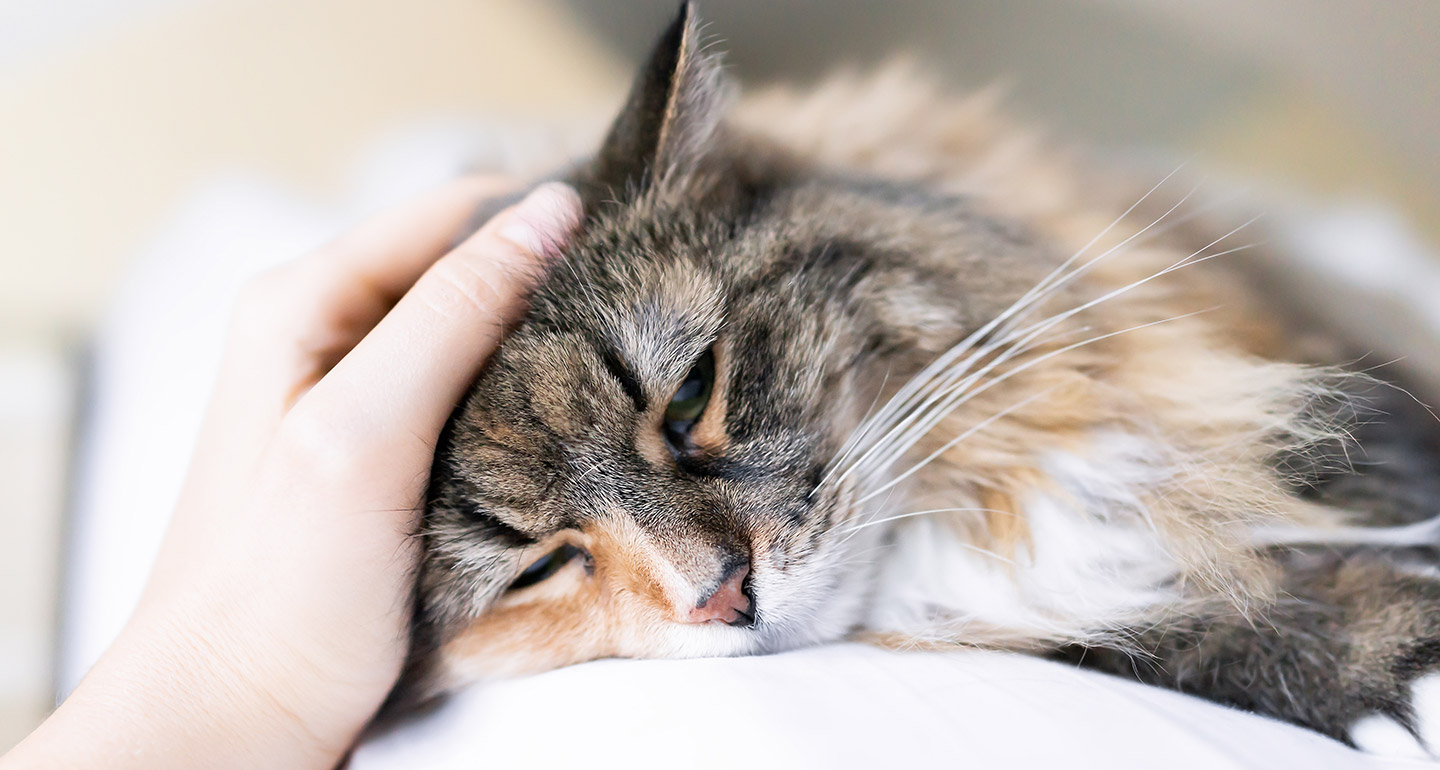Is your cat already a certain age and you’re worried about the possibility that he might have cancer?In this article, we’ll talk about this topic.
First, it’s important to know that not all tumors are cancerous, there are benign tumors and malignancies.With the help of this Animal Expert article, you’ll learn all about tumors in older cats, read on!
- As mentioned above.
- Not all tumors are cancerous.
- We consider a tumor to be an increase in the size of a part of the body.
- If this increase is due to growth in the number of cells.
- We call it neoplasm.
- Neoplasms can be both malignant (called cancer) and benign.
Benign neoplasm: it has an organized and slow growth, the borders of the neoplasm are usually well defined and do not migrate to other parts of the body (metastasis).
Malignancy: so-called cancer. Cells grow very fast and disorganize; In addition, they have the ability to invade other tissues and other parts of the body, called metastasis).
It’s very difficult to know what type of tumor it is without proper lab tests, so if you see a tumor in your cat, take it immediately to your veterinarian for diagnosis if it’s malignancy and treatment.you can start it quickly.
There are many types of cancer that can affect older cats (cats over the age of 10). The causes of cancer are also very varied, depending on the type of cancer in question.For example, breast cancer is usually associated with very high hormone values., being more common in unil sterilized cats.
Cancer in older cats can affect any part of the body or organ, in this article we will focus on the three most common cancers in older cats: breast cancer, lymphoma and squamous cell carcinoma.
Breast tumors are one of the most common tumors in older cats, the average age at which this tumor appears is between the ages of 10 and 12, breast tumors can be malignant or benign.It is estimated that about 85% of breast tumors are malignant.
Although rare, breast cancer may occur in male cats, but most commonly it appears in male cats, if you see a cat with a belly tumor, it can be breast cancer.
There is still no certainty about the causes of breast cancer in cats.However, there are some risk factors to mention. Some studies indicate that the Siamese breed and short-haired cats are more predisposed to breast gland tumors.
In addition, these tumors are much less common in sterilized cats.In addition, the age of castration of the cat may reduce the risk of this type of tumor.One study [1] showed that sterilized cats under 6 months of age reduced the risk of developing breast carcinoma by 91%, sterilized cats under the age of 1 reduced the risk by 86%.
Obese cats are also more prone to this type of cancer
Anti-heat injections are another possible cause of breast cancer, several expert studies indicate that the administration of the pill to cats and anti-heat injections greatly increase the likelihood of developing cancer, so Animal Expert is totally against this type of contraceptive in dogs and cats.
Most of the time these tumors are detected by the veterinarian during the consultation during the palpation of the 10 mammary glands that the cat has, these tumors usually go unnoticed by tutors, so regular visits to their trusted veterinarian are so important.In addition, it may be accompanied by other symptoms such as:
If you have an elderly cat that is losing weight, you should take it to a veterinarian as soon as possible. Anorexia is a common clinical sign of many diseases and it’s important to diagnose your cat as soon as possible to start the most appropriate treatment..
The most common diagnostic methods are cytology and biopsy, and blood tests will help the veterinarian determine the stage of cancer in which the cat is located.
Your veterinarian may also advise you to have an X-ray to rule out any pulmonary metastases.
The most common treatment is tissue removal surgery in the presence of a tumor.In some cases, the veterinarian may recommend a complete mastectomy (removal of all mammary glands), especially if there is more than one breast tumor.
The best way to prevent breast cancer in cats is to neuter your cat before 6 months because as we have already mentioned, this reduces the chances of getting breast cancer by 91% compared to non-spayed cats.
Lymphoma is one of the most common malignancies in cats.Approximately 30% of tumors in cats are lymphomas.Lymphoma is a cancer that affects lymphocytes (white blood cells). These blood cells are the main warriors of the cat’s immune system, i.e. its defenders whenever there is an invasive bacteria or virus. Lymphocytes travel throughout the cat’s body into the bloodstream.to defend against these so-called invaders, and therefore, if there is cancer in the lymphocytes, it also spreads throughout the body.
There are three types of lymphoma: multicenter lymphoma that mainly affects the lymph nodes of the cat, the mediatinal that focuses mainly on the chest cavity and food lymphoma that mainly affects the gastrointestinal tract.
Although studies are still ongoing and not all causes have been determined, Felv is known to be involved in the development of lymphoma in cats, since as Felv is a retrovirus, it lodges in DNA and can alter cell growth. leading to the formation of neoplasms. Studies indicate that about 25% of cats with Felv develop lymphoma, however, with advances in medicine and the existence of felv vaccines, there are fewer and fewer lymphomas caused by felv.
According to some studies, some Eastern and Siamese races are more likely to develop lymphoma.
As mentioned above, this cancer can affect various parts of the cat’s body, most commonly affecting the gastrointestinal tract. The most common symptoms of lymphoma in cats are:
As you can see, the symptoms of lymphoma in cats are very similar to those of other diseases, so visiting the veterinary doctor is essential for an early diagnosis of this very serious cancer.
In some rarer cases, such as the cat shown below, lymphoma affects the oral cavity and causes serious injury.
The best way to diagnose lymphoma is chest and abdominal x-ray and ultrasound, through these imaging methods, veterinarians can observe an increase in lymph nodes and changes in the organs that help them reach the diagnosis of lymphoma . The affected site allows a definitive diagnosis.
Because lymphoma affects the entire body of the animal, because lymphocytes circulate freely in the bloodstream throughout the body of the animal, a simple surgery does not solve the problem. If there are tumors or obstructions caused by the disease, surgery may be necessary, but chemotherapy is essential in treating lymphoma.
In addition to chemotherapy, your vet can advise you on a specific omega-3-rich diet.
The best way to prevent this disease is to properly vaccinate your cats, however, as mentioned above, lymphoma is not always associated with Felv and there is still no explanation for the onset of this cancer, so the best thing you can do as The Guardian is to consult periodically with your veterinarian, to make sure that if something happens , you are diagnosed quickly.
Read our full article on lymphoma in cats: symptoms, diagnosis and treatment.
Squamous cell carcinoma is one of the most common tumors of the skin and subcutaneous tissue; most cats with this type of skin cancer in cats have damage to the head, nose, ears and eyelids, sometimes even in the fingers.Although there are cases of this tumor in young cats, the most common is that it occurs in cats over the age of 11, I feel a common tumor in older cats.
Although there is still no certainty about the causes of this type of tumor, sunlight is already known to contribute to the development of this neoplasm, some studies also indicate that white cats are more likely to develop this type of tumor.cats are the least predisposed to develop squamous cell carcinoma.
The most common symptomatology are the lesions that we have already mentioned, ulcers may appear in plaque or in the form of cauliflower in the nose, ears and eyelids, which usually begin with small lesions and, over time, eventually ulcerated, worsening the condition of the animal.
Although the tumor is aggressive locally (on the animal’s face), it doesn’t usually migrate elsewhere, so the cat can have only these lesions and cats are seen with nose cancer without other associated symptoms.
The veterinarian should perform the necessary tests to confirm the diagnosis, as there are other diseases with similar symptoms, such as mastocytoma, hemangioma, hair follicles or sebaceous glands, etc.
The most common tests are aspiration cytology and tumor mass biopsy, i.e. the veterinarian should collect part of the tumor and send it to the lab for analysis.
There are different treatment options for squamous cell carcinoma.The type of treatment depends on the stage at which the tumor was diagnosed, the condition of the tumor, and the condition and age of the animal.Each type of treatment has different side effects and you should consult with your oncology veterinarian the best option for the specific case of your cat.
The most common treatments for squamous cell carcinoma are
Since there is a strong influence of ultraviolet rays and sunlight on the development of this tumor, it is important that you restrict your cat’s access to the sun.
What is most recommended is that the cat can only sunbathe at the beginning and end of the day, especially if it is a cat predisposed to this disease, such as whiter cats.or with lighter mucous membranes.
If your cat likes to spend most of the day in the window, you need to make sure the glass is protected from ultraviolet rays.
Your cat’s chances of surviving cancer depend on the type of tumor in question, how quickly it was detected, and the condition of the cancer.
The most important thing is that as soon as you detect a tumor in your elderly cat, go immediately to your trusted veterinarian.
Read our full article on How long does a cat live with cancer?
This article is for informational purposes only, in Animal Expert.com.br we cannot prescribe veterinary treatments or make any type of diagnosis, we suggest that you take your pet to the veterinarian in case of any condition or discomfort.
If you would like to read articles similar to Tumors in older cats, we recommend that you visit our Other Health Problems section.

